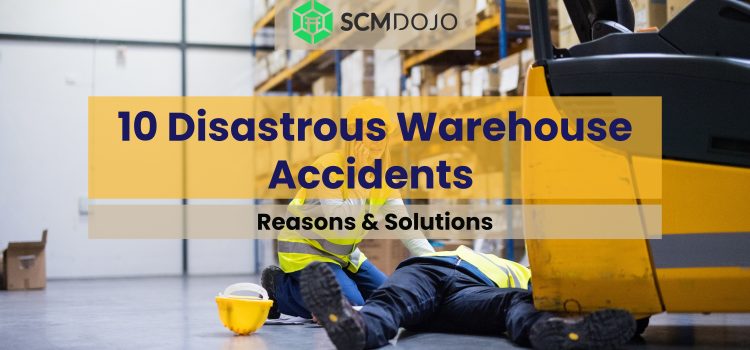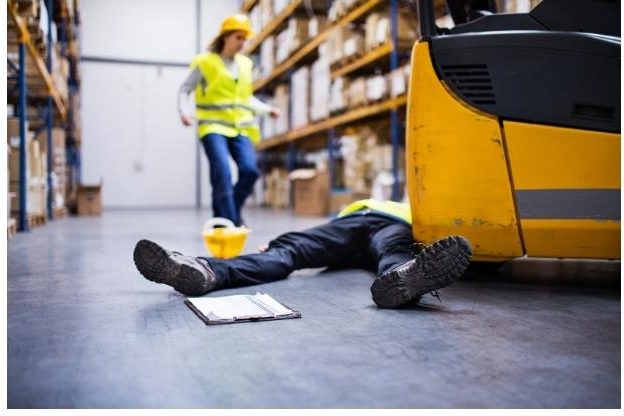In a bustling warehouse, safety should always be a top priority. Unfortunately, accidents can happen, posing serious risks to workers and operations. Understanding and being aware of common warehouse accidents is essential for preventing them in the first place. Look at some common warehouse accident pictures and you’ll notice most are forklift accident pictures.
This article will shed light on 10 common warehouse accidents you need to know about to create a safer work environment. From slips, trips, and falls to forklift incidents and falling objects, warehouses are filled with potential hazards. By identifying these risks and implementing preventive measures, you can significantly reduce the likelihood of accidents occurring.
Whether you are a warehouse manager, an employee, or someone interested in workplace safety, this article will equip you with the knowledge to spot potential dangers and take proactive steps to keep everyone safe. Don’t let preventable accidents disrupt productivity and put lives at risk—stay informed and prioritize safety in your warehouse.
Common warehouse accidents and their causes
Warehouses are dynamic environments where goods are stored, sorted, and distributed. The sheer size and complexity of these facilities make safety a crucial aspect of daily operations. A commitment to warehouse safety not only protects the well-being of employees but also safeguards the integrity of the products and the overall efficiency of the supply chain.
One of the primary reasons why warehouse safety is so vital is the potential for accidents to occur due to the presence of multiple hazards. From heavy machinery and equipment to slippery floors and high shelves, various factors can contribute to accidents. By prioritizing safety, warehouse managers can ensure that their employees can work in a secure environment, reducing the risk of injuries, costly lawsuits, and damage to inventory.
Creating a culture of safety within a warehouse also has the added benefit of boosting employee morale and productivity. When workers feel that their well-being is valued and protected, they are more likely to be motivated and engaged in their work. Moreover, a safe warehouse reduces downtime due to accidents, resulting in improved efficiency and higher customer satisfaction.
According to some sources, the most common causes of warehouse accidents are:
- Slips and trips due to wet, slippery, or cluttered floors
- Forklift accidents due to improper training, maintenance, or operation
- Falling objects due to improper stacking, loading, or securing of items
- Electrical shock due to sub-standard wiring or system design
- Fire and explosion hazards due to flammable materials, poor ventilation, or faulty equipment
- Repetitive motion injuries due to ergonomic issues, lack of breaks, or poor posture²⁴
Looking for information on how to prevent these accidents?
Warehouse Automation:
However, while training minimizes risk, a surefire way of decreasing warehouse accidents is by eliminating waste and hazards within the warehouse. A proven method to achieve this is by optimizing the warehouse with automation.
Automation requires using Automated Guided Vehicles (AGVs) that are programmed to work autonomously, maintaining the flow and visibility of goods throughout the warehouse. They need no driver or operator, working from pre-programmed pathways developed to ensure the most efficient use of space.
As the AGVs stick to delineated pathways and take over the manual handling of goods that employees traditionally undertook, the risk to employees is significantly reduced.
Read more on Warehouse Automation: Definition, Benefits and Issues at our website SCMDOJO.
Visual Barriers
The best way to prevent warehouse accidents with pedestrians is with visual barriers such as:
- A quick-mount barricade or other barrier system
- Signage warning the pedestrians they are entering a hazardous area
- Blue lights, and red zone warning lights to designate an area where heavy equipment is approaching or operating
- Audible hazard indicators from backup alarms to simply shouting, “coming through!” can also prevent accidents.
Initial Measures
Avoid accidents in the first place by:
- Ensuring adequate ventilation to disperse fumes from gassing batteries
- Providing rubber gloves, eye and face protection, and other protection
- Enforcing required procedures when refueling gas or propane forklifts
- Utilizing conveyors, overhead hoists, etc. for servicing batteries
- Be prepared for the worst-case scenario. Confirm all employees know how to find the closest eye wash station, first-aid kit, or fire extinguisher. This can mean the difference between a minor and a major accident. Also, be sure your fire extinguishers are current and fully charged.
Read more on: “Ensuring Safe Material Handling in Warehouses” at our website SCMDOJO
Importance of warehouse safety
In a bustling warehouse, safety should always be a top priority. Unfortunately, accidents can happen, posing serious risks to workers and operations. Understanding and being aware of common warehouse accidents is essential for preventing them in the first place. This article will shed light on 10 common warehouse accidents you need to know about to create a safer work environment.
From slips, trips, and falls to forklift incidents and falling objects, warehouses are filled with potential hazards. By identifying these risks and implementing preventive measures, you can significantly reduce the likelihood of accidents occurring. We will delve into each accident type, providing insights on how they happen, their potential consequences, and most importantly, the measures you can take to prevent them.
Whether you are a warehouse manager, an employee, or someone interested in workplace safety, this article will equip you with the knowledge to spot potential dangers and take proactive steps to keep everyone safe. Don’t let preventable accidents disrupt productivity and put lives at risk—stay informed and prioritize safety in your warehouse.
Reasons why warehouse accidents can occur and How to Prevent them
Here are the reasons why these accidents can occur. We have compiled all the reasons and their solutions in detailed descriptions to prevent each of them:
1. Inadequate Training:
Insufficient training for warehouse workers can lead to accidents when they are not aware of safety protocols or proper handling techniques.
Solution:
- Employers should provide comprehensive training programs for all warehouse staff, including safety protocols, equipment operation, and emergency procedures.
- Regularly update training materials to incorporate the latest safety guidelines and best practices.
- Conduct refresher training sessions to ensure that workers are always aware of safety measures.
You can access the Modern Warehousing and Distribution Centers Course at our website SCMDOJO
2. Lack of Awareness:
Workers might not pay enough attention to their surroundings, machinery, or the movement of other workers, leading to collisions or accidents.
Solution:
- Implement strict rules about keeping attention on the task at hand and surroundings.
- Encourage the reporting of near-miss incidents to create awareness and prevent similar accidents in the future.
- Use signs, mirrors, and designated walkways to improve visibility and awareness within the warehouse.
3. Equipment Malfunctions:
Defective or poorly maintained equipment, such as forklifts or conveyor belts, can be a major cause of accidents.
Solution:
- Establish a routine maintenance schedule for all warehouse machinery and equipment.
- Implement a system for reporting and addressing equipment issues promptly.
- Regularly inspect and replace worn-out or damaged parts to prevent breakdowns.
4. Poorly Designed Layouts:
Warehouses with inefficient layouts or congested pathways can increase the risk of accidents.
Solution:
- Reevaluate and optimize the warehouse layout to minimize congestion and improve traffic flow.
- Mark pedestrian and vehicle pathways to prevent collisions.
- Use barriers and guardrails to create safe zones and separate work areas.
5. Overexertion:
Workers lifting heavy objects without proper techniques or assistance can suffer injuries.
Solution:
- Train workers on proper lifting techniques, emphasizing the importance of using their legs, not their backs.
- Encourage using assistive equipment like pallet jacks or forklifts for heavy loads.
- Promote a culture of teamwork, so workers can request assistance when handling heavy items.
Read more on Benefits of Increasing Worker Safety Through Automation at our website SCMDOJO.
6. Inadequate Safety Gear:
Not providing or using appropriate safety gear, such as helmets, gloves, or safety shoes, can result in injuries.
Solution:
- Provide appropriate safety gear based on the specific tasks and hazards in the warehouse.
- Regularly inspect and replace safety gear that is worn or damaged.
- Ensure that workers understand the importance of wearing safety gear at all times.
7. Rushed Work Environment:
Pressure to meet tight deadlines can lead to workers rushing and making mistakes.
Solution:
- Establish realistic production schedules that allow for adequate time to complete tasks safely.
- Encourage open communication between management and workers to address concerns about deadlines.
- Reward and recognize workers for maintaining safety standards, not just productivity.
8. Human Error:
Mistakes in judgment or lapses in concentration can result in accidents.
Solution:
- Implement error-proofing measures where possible, such as automated systems and double-check procedures.
- Conduct incident investigations to understand the root causes of accidents and develop preventive measures.
- Encourage a culture of accountability and continuous improvement.
9. Lack of Communication:
Poor communication among workers can lead to misunderstandings and accidents.
Solution:
- Promote clear communication channels among all workers, supervisors, and management.
- Use technology like radios or messaging apps to facilitate real-time communication.
- Conduct regular safety meetings to address concerns and improve communication.
10. Hazardous Materials:
Mishandling or inadequate storage of hazardous materials can lead to chemical spills or other accidents. To prevent warehouse accidents, employers must prioritize safety training, maintain equipment, improve facility layouts, and promote a culture of safety among workers.
Solution:
- Ensure proper labeling and storage of hazardous materials, following regulatory guidelines.
- Provide specialized training for workers handling hazardous substances.
- Maintain an updated emergency response plan in case of spills or leaks.
By addressing these reasons systematically, warehouses can significantly reduce the risk of accidents and create a safer working environment for their employees.
Why sleep is crucial for warehouse workers
Having a good night’s sleep is crucial for warehouse workers because it directly impacts their performance, safety, and overall well-being:
1. Alertness and Focus:
Adequate sleep improves alertness, concentration, and cognitive function. Warehouse workers need to stay focused to operate heavy machinery, manage inventory, and avoid accidents.
2. Physical Stamina:
Restorative sleep helps maintain physical stamina, endurance, and energy levels required for tasks like lifting, carrying, and maneuvering goods within the warehouse.
3. Safety:
Fatigue due to lack of sleep increases the risk of accidents, which can be dangerous in a warehouse environment with heavy equipment and materials.
4. Decision-Making:
Good sleep enhances decision-making abilities, enabling workers to make quick, accurate choices when managing inventory or responding to unexpected situations.
5. Health and Well-being:
Consistent sleep is essential for overall health. It boosts the immune system and helps the body recover from physical strain, reducing the chances of illness or injuries.
6. Reduced Errors:
Sleep deprivation can lead to errors in order fulfillment, inventory tracking, and shipping, which can be costly for both the worker and the company.
In summary, a good night’s sleep is the foundation for physical and mental well-being, safety, and productivity in a warehouse setting.
Conclusion
In warehouse operations, safety is a top priority. This blog breaks down the top 10 accidents, analyzing causes and consequences. It’s a guide for managers, employees, and safety advocates. Beyond protecting workers, the blog emphasizes the strategic importance of warehouse safety for product integrity and supply chain efficiency.
The narrative goes beyond identifying risks, and offering practical solutions. From comprehensive training to automation, each challenge has proactive strategies. The article also stresses the role of sleep in worker well-being. Using the Warehouse Safety Audit Tool proactively strengthens the commitment to safety, ensuring a resilient future for warehouse operations.
Recommended Reading
How to Integrate WMS to My Business
Warehouse Safety Audit Tool- Beware of Accidents and Injuries









